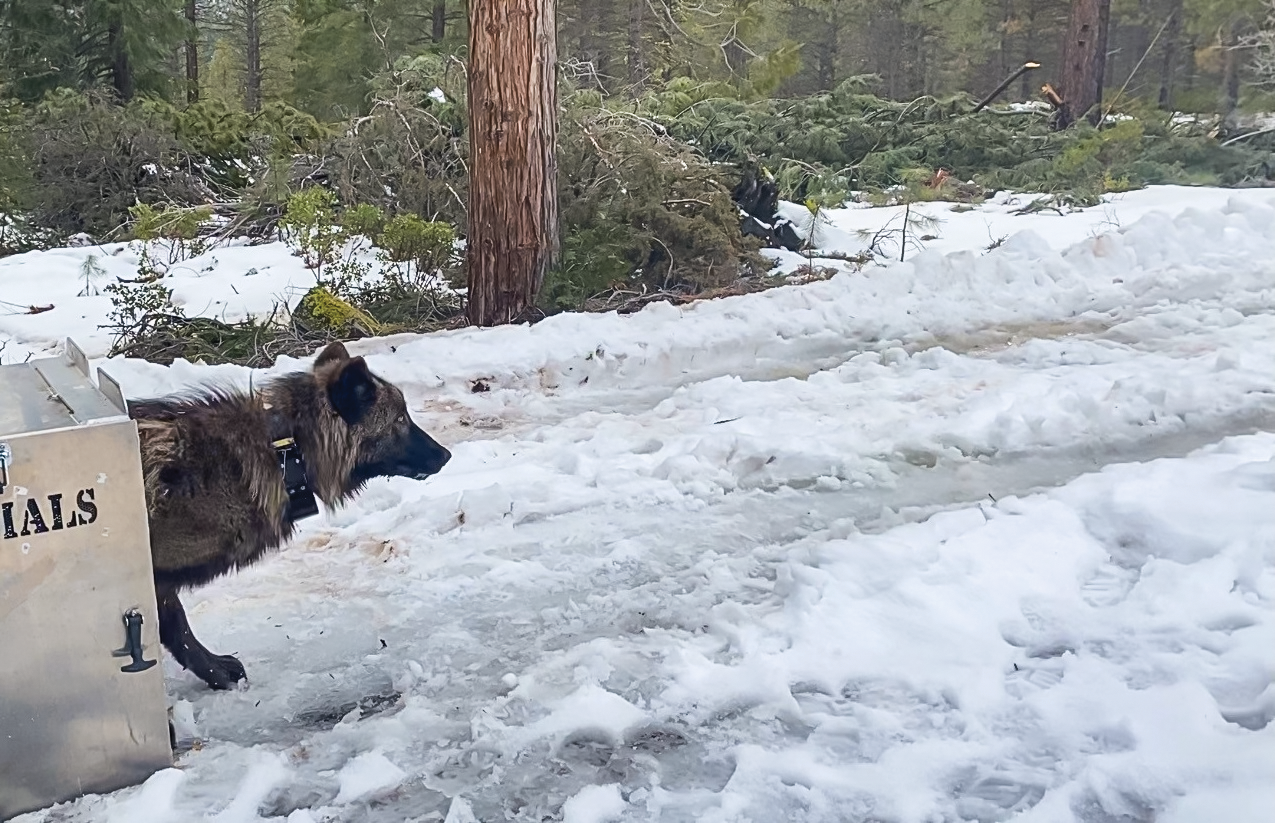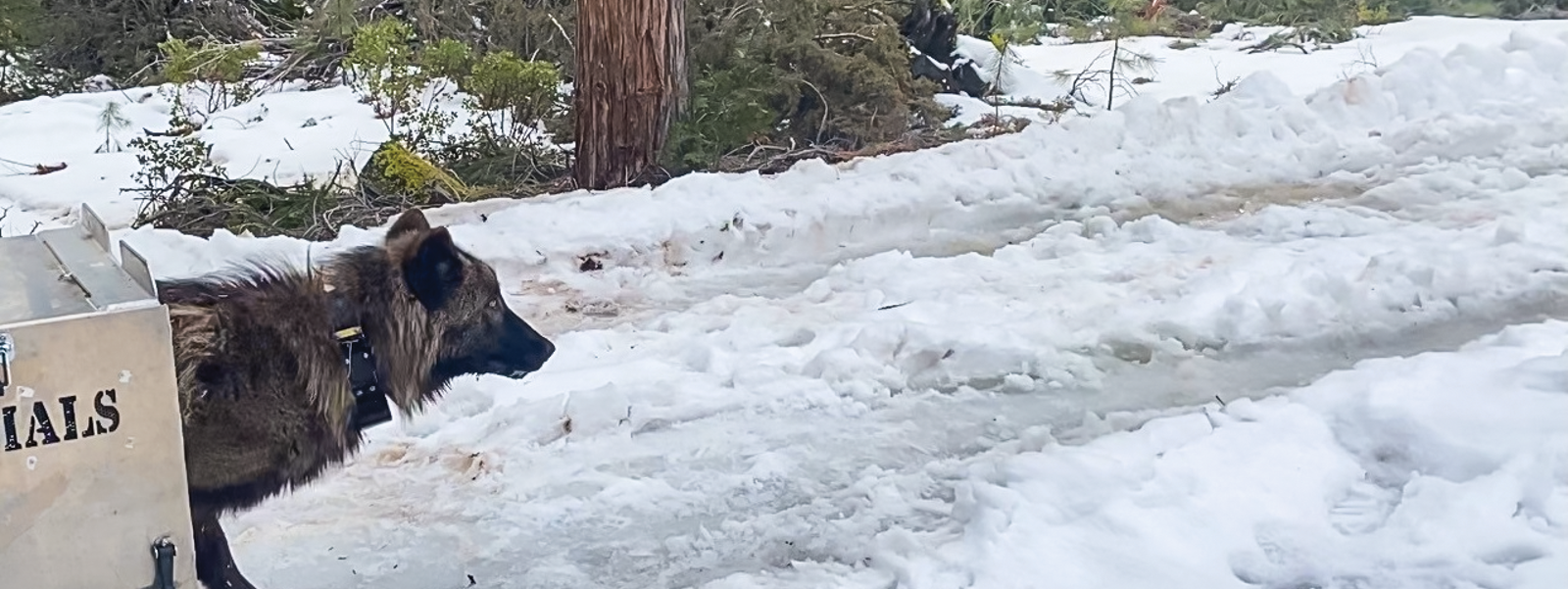Wolf program to pay ranchers for livestock impacts

A yearling male wolf from the Whaleback Pack in Siskiyou County returns to the wild after the state Department of Fish and Wildlife outfitted the predator with a satellite collar in March.
Photo/California Department of Fish and Wildlife

By Ching Lee
As a sheep and cattle rancher who’s had wolves come through his Siskiyou County property, Jeff Fowle has seen the impacts on his livestock with the predators being around.
None of his sheep and cattle have so far been killed by wolves, but their behavior has “noticeably changed,” he said. When there’s a wolf in the area, the stress on his animals causes them to lose weight, he added. Breeding is also affected.
A new state program has Fowle “cautiously optimistic” that he would be compensated for some of the impacts. The program pays ranchers for livestock losses due to wolf depredation. It also reimburses ranchers for the cost of using nonlethal tools such as livestock guardian dogs, fladry fencing and range riders to deter wolf depredation. Perhaps more importantly, the program pays for impacts of wolf presence on livestock.
“That is going to be a significant aid,” Fowle said.
Though other states such as New Mexico also pay for wolf presence, no other wolf compensation program in North America offers all three components as in the state program, said Vicky Monroe, conflict programs coordinator for the California Department of Fish and Wildlife.
The state allocated $3 million for the pilot program. The first two parts—compensating for livestock losses and deterrence—were implemented last year. Implementation of “pay for presence” remains “imminent,” Monroe said, adding she expects it will start this spring. Compensation is retroactive from Sept. 23, 2021 through June 20, 2026, or when funds run out.
As of last week, 32 application packages have been processed and approved, with a total compensation request of $437,851.70, Monroe said. Of the 32 applications, 11 are for direct livestock losses and 21 are for deterrence methods.
Under the program, Fowle will be compensated for the loss of two guardian dogs that were killed by wolves. He will also be reimbursed for costs of replacing the two dogs. The program does not pay for regular costs associated with keeping guardian dogs, such as feeding them, Monroe said. But time and labor spent on monitoring wolves and livestock, herd management, husbandry practices and removing wolf attractants are considered allowable costs eligible for compensation, she added.
To protect his sheep, Fowle said he’s been locking them up in the barn for the past year and half, which he didn’t have to do in the past. He’s also running his cattle closer to home when they’re calving, which means he’s feeding hay instead of letting them graze on ground where he’s seeing wolves. The pasture is wasted because he doesn’t want to run the risk of losing livestock, he said.
“It’s a pain in the neck,” Fowle said. “I really do not appreciate (wolves) being here.”
Though the compensation program begins to assist ranchers with wolf-related financial losses, ranchers tend to agree that aspects of the program need tweaking.
For example, the program pays for livestock death and injury due to “confirmed” or “probable” wolf depredation, as determined by CDFW investigations. Some ranchers believe cases ruled as “possible” depredation should also be eligible for compensation, especially when there was evidence of wolf presence at the site and the carcass was too fully consumed to make a determination.
“Often environmental factors mess up the carcass,” said Katie Little, policy advocate for the California Farm Bureau. “Maybe the rancher doesn’t even see it within the first 24 hours.”
She said there are also “major concerns” with the pay-for-presence component of the program, which has a strict formula on how it pays ranchers based on the percentage of their grazing allotment that falls within known wolf-pack territory. Payment is higher within the core area where wolves are most of the time and less in the peripheral area.
Other rancher frustrations relate to the lack of updated data on known wolf territory. CDFW last month collared two wolves in the Whaleback Pack, which occupies a 341-mile home range in eastern Siskiyou County, according to the department. The GPS collars allow CDFW to track the wolves’ whereabouts. But no other wolves in the state are currently fitted with functional radio collars, and that has stymied the department’s identification of pack territory and core range, ranchers point out.
The program does not compensate ranchers for the presence of a dispersing wolf outside of known pack territory. The department has said dispersing wolves travel widely and may not be in one place long enough to cause health effects on livestock, Little said.
Siskiyou County rancher Pat Griffin said he was hoping the program would use a “multiplying factor” to increase pay for ranchers who are harder hit, as they’re likely spending more time in the field than those who may not have as many depredations.
Griffin, who retired in 2015 as the county’s agricultural commissioner, now serves as the region’s wolf consultant. He monitors wolves with his own trail camera and notifies ranchers on where wolves are most recently. He also helps investigate depredations, assisting in necropsy and looking for evidence.
Griffin acknowledged it’s sometimes difficult to make a probable or confirmed wolf-kill determination if there’s not much carcass left. He said the response time in getting someone to the investigation site is usually within hours, at least in his county. The problem is detecting the carcass and finding the lost animal, he said.
“We’ve had lots of cases where we get called, and it’s three or four days old or more,” he said. “When you’ve got wolves, you’re going to have those losses that you can’t really confirm, so the pay for presence helps make up for that.”
Compensating ranchers for wolf depredation remains controversial within the ranching community. Rancher Fowle calls it “a double-edged sword.” While it’s helpful that they’re reimbursed for losses they incur, ranchers say, the payments do not begin to replace the true value of the lost animals and their genetics, which sometimes take generations to build.
Because of multiple wolf depredations, Billie Roney and her husband Wally are unable to use all their leases and federal permits in Lassen County. She described some of that territory as “the killing fields,” saying she and her husband no longer run calves in the mountains because “they’re just appetizers.” But she also expressed uneasiness about taking compensation for wolf-related losses.
“Once you compensate me for the wolf kills, it’s like agreeing that it’s OK. The other side says, ‘It’s no big deal,’” Roney said. “That’s the part I’m not OK with.”
Siskiyou County rancher Jim Morris faced similar public reaction when he gave a presentation from a rancher’s perspective at the Oakland Zoo, where the crowd was “really pumped up about wolves.” He said he tried to explain why ranchers and rural communities have concerns about wolves by using an analogy of a thief breaking into someone’s home and pillaging the owner’s belongings.
“‘But you shouldn’t worry about it because you have insurance,’” he told the crowd. “I have many people come up to me and tell me later that that really resonated with them, and they get why I might feel the way I do.”
(Ching Lee is an assistant editor of Ag Alert. She may be contacted at clee@cfbf.com.)




